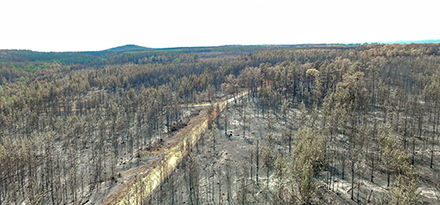
Record temperatures globally over the past few years have generated unprecedented high Forest Fire Danger Index conditions. These conditions have extended the duration of the traditional fire season in many regions and, of more concern, have been the catalyst for losses in regions not normally impacted by fire. Source: Timberbiz
As a consequence, plantation insurers have been affected by increased losses which have undermined their profitability on what is already a difficult class of insurance to underwrite.
This difficulty arises from the nature of the insured perils, namely fire and windstorm, which are classified as “catastrophe type” perils – in that they are relatively low frequency but high in terms of severity.
As such significant losses can undermine the profitability of the insurer’s portfolio for many years even if they have a well-balanced global plantation insurance portfolio.
While the 2018/19 Fire season was relatively benign in Australia the month-long duration of the Tasmanian fires caught the local insurers by surprise and this together with the losses encountered in WA and VIC continue to place pressure on the specialist local insurers.
The coming fire season, based on the generally dry winter in south eastern Australia, the Bureau of Meteorology’s August to October outlook, and climate change creates even greater risks.
The National Head of Agriculture at NSW-based insurer AgriRisk John van der Vegt said fire risk in a region is generally measured by reference to the Forest Fire Danger Index which is related to the chances of a fire starting, its rate of spread, its intensity, and its difficulty of suppression, according to various combinations of air temperature, relative humidity, wind speed and both the long and short-term drought effects.
“So logically, if the drought or hot, dry conditions continue this will weigh on the overall fire risk,’’ Mr van der Vegt said.
The BOM climate outlook for August to October suggests:
- The August to October climate outlook, issued 25 July 2019, suggests a drier than average three months is likely for large parts of Australia.
- August to October daytime temperatures are likely to be warmer than average for much of Australia, with very high chances for the northern half of country.
“So, the outlook for the 2019/20 fire season doesn’t look great at this point in time,’’ he said. “We currently await the updated Bushfire Outlook from the Bushfire and Natural Hazards CRC which is due in September.’’
Mr van der Vegt said the reality was that climate change will see an increased likelihood of catastrophic fire conditions in many regions.
“With higher temperatures and lower rainfall we should also expect fire seasons to start earlier and last longer and see fires in areas that are generally considered relatively low risk, such as Scandinavia and Alaska, or closer to home in southern Tasmania.”
Most plantation owners insure their plantations against fire. Even the largest estates are generally insured notwithstanding their geographical spread of risk and significant ongoing investment in fire preparedness and suppression capability. They insure because they understand that;
- The financial impact of fire losses can extend well beyond the current financial year results and significant catastrophe type losses could impact the ongoing viability of the business.
- Fires will still occur notwithstanding having the best plantation management and fire risk management strategy.
- Fires can’t always be controlled regardless of their own internal and external fire suppression capability. In catastrophic fire conditions, staff safety is paramount and external fire agencies will often be diverted to protect more important assets.
This risk is of course much higher for single plantation owners whereby a single loss event can completely destroy the long-term investment.
Mr van der Vegt said recent catastrophic global losses and the ongoing dry conditions continue to weigh heavily on the local insurers.
“As a consequence, we are seeing a continuation of the hardening market conditions. This means further upward pressure on premium rates, reductions in available capacity and minimum requirements on key parameters such as the excess.”
“So, in this hardening market plantation owners needed to be prepared to make some changes to your cover to meet your budget.”
They would need to review;
- The perils you are insuring and the limits that apply.
- The sums insured per hectare you have nominated.
- The additional benefits you have selected and the limits that you require.
- The excess structure and level – this can have the biggest impact on your premium.
“Finally, make sure you are canvassing the insurance market as the participating insurers have different perceptions of risk (management, plantation, regional and climatic) which can result in significant differences in the premiums they require to underwrite the risk,” Mr van der Vegt said.





